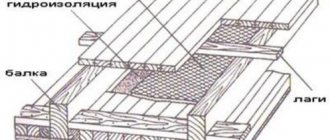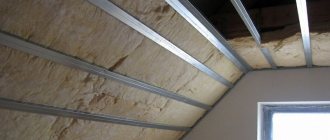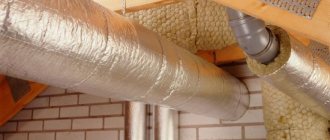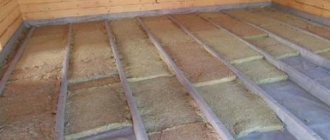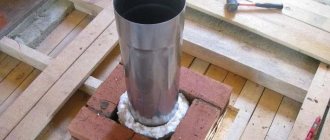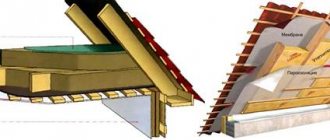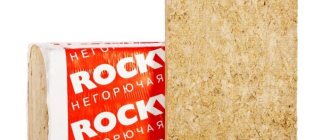Regardless of whether there is a screed under the floor or just a filling of expanded clay, or maybe there is even damp earth under the floor, in order for the floorboards of a wooden floor to be warm, the space under the top flooring will need to be insulated.
For this, the well-known and most common method is used: insulating the floor along the joists. What logs are and what insulation is best suited for thermal insulation of wooden floors, as well as what schemes are best to implement this will be discussed in our material.
Types and properties of floor insulators
Materials used for insulating floor coverings are produced in the form of:
- granules - expanded clay, foam glass, perlite, vermiculite granulated slag;
- rolls with and without a reflective layer - mineral wool, glass, slag, polyethylene foam, polystyrene foam, cork;
- foil and non-foil boards - polystyrene foam, penoplex, polystyrene foam, chipboard, OSB, plywood, wood concrete, basalt wool;
- liquids and foam - special insulating paints, polyurethane foam, ecowool;
- mixtures - foam concrete, polystyrene concrete, expanded clay concrete, slag concrete, sawdust concrete.
Mineral wool is an affordable material for insulation. Source giropark.ru
They have general technical characteristics that allow the materials to be widely used for thermal insulation:
- Fire resistance - do not support combustion.
- Low thermal conductivity coefficient - retains heat well in the room.
- Environmentally friendly, safe for use inside a residential building.
- Durability - with proper installation, materials retain their properties for at least 20 years.
- Simplicity of the installation of the thermal insulation layer - no highly professional knowledge or complex operations are required.
- Resistant to rot, mold, fungi.
- Lightweight - does not additionally load load-bearing structures.
- Low water absorption - they do not absorb or retain moisture in capillaries and pores.
- Vapor permeability - air exchange is ensured in the room, a favorable microclimate is maintained.
- Strength is especially important when constructing concrete pavements, where the load is transferred directly to the insulation.
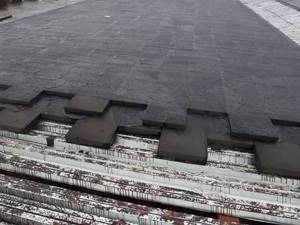
Modern thermal insulation materials are inexpensive and effectively cope with floor insulation in a private house.
The best manufacturers
Insulation materials are produced by many well-known companies. Let's consider those of them that supply products with proven quality, and therefore are the most popular.
Knauf . This company, which has existed for more than 90 years, produces insulation materials that are popular all over the world, using innovative technologies and natural raw materials. All heat insulators (for example, the TeploKnauf brand) are safe and environmentally friendly.
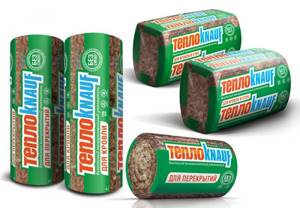
Safe and environmentally friendly insulation materials TeploKnauf
Ursa . The manufacturer produces both mineral wool and fiberglass. The products are quite affordable. Ursa entered the domestic market relatively recently, and therefore the products of this brand are not very popular in our country yet. However, demand is constantly increasing due to low prices.

Ursa mineral wool is convenient and easy to install
Rockwool . One of the leaders in its segment, primarily engaged in the production of basalt insulation materials, characterized by affordable prices and excellent performance characteristics.
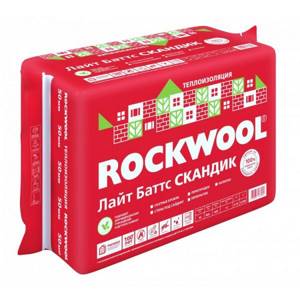
Rockwool company is one of the leaders in its segment
Isover . This company also focuses primarily on mineral wool and supplies stone and glass wool to the building materials market (which is good, because both options are often used in construction). Isover insulation materials are very durable and elastic, and are excellent value for money.
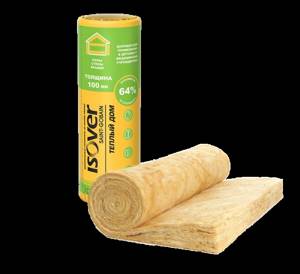
Isover company produces environmentally friendly materials that are safe for human health.
Paroc . Another manufacturer of insulation materials that specializes more in mineral wool (its quality has been tested over the years). The company focuses on saving heat when heating and effective sound insulation. But Paroc insulation is quite expensive, this is their main disadvantage.
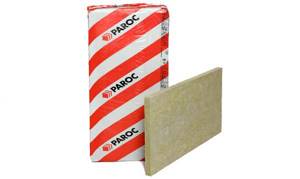
Paroc insulation does not retain moisture and does not lose its properties when temperature changes
Video - Insulation testing: Rockwool, Teploknauf and Teploknauf NORD
Features of the use of insulation
Today, the buyer is offered a wide range of thermal insulators for floors. To select the most suitable material, you need to take into account the features of their installation and use.
Bulk insulators
Used for insulating wooden, concrete, tiled floors in a private home.
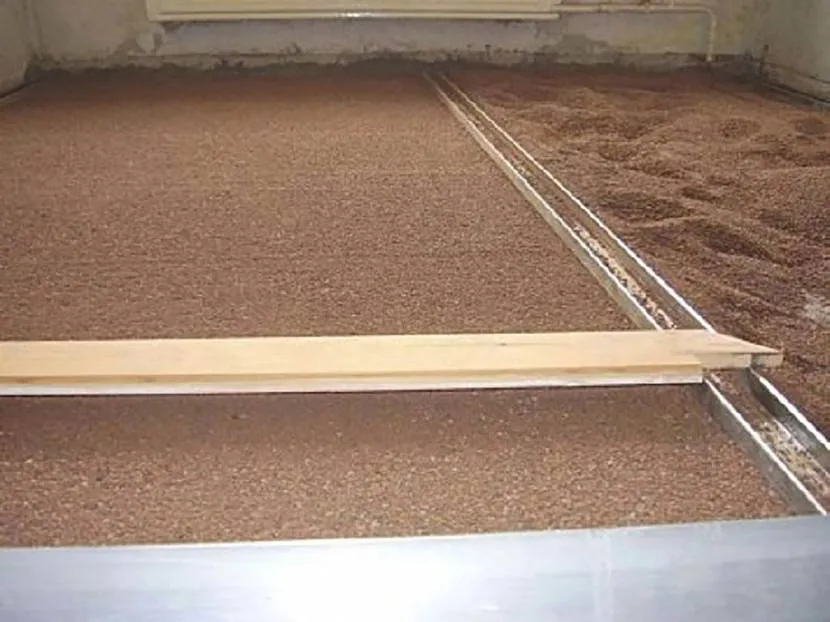
Expanded clay is one of the options for bulk insulator Source stroyfora.ru
The material is poured between the lags or onto a prepared surface protected from below from moisture penetration. The insulator is compacted and a leveling screed is placed under the final coating. The minimum layer thickness is 5-15 cm.
Roll insulation
Place it on a flat surface, insulated from moisture, and cover it with a layer of vapor barrier.

Roofing felt is easy to install and inexpensive Source th.decorexpro.com
Install the flooring from boards or plywood and the finishing coating. For concrete floors, polystyrene foam is used; wooden floors are better insulated with mineral wool. When installing foil materials, make sure that the metallized layer is on the surface. This will allow heat to radiate into the room without loss.
Slab heat insulators
The mats are laid in the spaces between the joists or in a checkerboard pattern on concrete foundations. Protection from moisture below and steam from above is required. Before final finishing, it is recommended to reinforce the insulation surface.
Liquid thermal insulation
Used to protect wooden, concrete and plastic floors from heat loss.

Liquid insulation retains heat well despite the thin ball Source remtra.ru
Heated floor systems
Underfloor heating systems have proven themselves in creating a comfortable microclimate in the house. They are satisfied:
- based on water heating;
- with connection to a power source.
Insulation with a metallized coating is used, on top of which small-diameter pipelines, electrical mats, cables or infrared emitters are laid. The reflective layer directs thermal radiation into the room, preventing heat loss. The structure is covered from above with a screed or flooring material.

Warm floors for comfortable living Source utepleniedoma.com
Advantages of the systems:
- Ease of installation.
- Economical in operation.
- Small thickness of structures.
- Even heat distribution.
- Environmentally friendly.
- Reliability.
- Safety.
A warm floor can be the main or additional element of the heating system of a private home.
Three main ways to insulate floors in a private home
The base is a reinforced concrete slab, a wooden subfloor on joists or soil. Warming is carried out in a certain order. It is advisable to entrust the process to professionals, but to understand what is happening, you can familiarize yourself with the algorithms.
Thermal insulation device for the floor on a reinforced concrete slab
- The surface is cleaned, leveled, and the seams are sealed with mortar.
- Lay a vapor barrier film with sizing of joints if mineral-based insulation is used. Polystyrenes do not need protection from moisture.
- Place thermal insulation - slab, roll, bulk.
- Reinforce the surface with mesh.
- Fill the cement-sand screed.
- In damp rooms, waterproofing is installed to protect the insulation from moisture.
- Install the covering - laminate; tiles; parquet; board.
Thermal insulation of floors on joists
- Logs—beams with a special cross-section—are laid on the support columns.
- A galvanized mesh or board is attached to the bottom of the beams.
- A wind and moisture protective membrane is spread, the joints are glued, and secured with a stapler to the beam.
- Insulation is laid - slabs, rolled materials with a thickness no less than that calculated for a given climatic zone.
- The top is insulated from moisture with steam and waterproofing, securing it to the joists and gluing the joints.
- Plywood or boards are placed along the top of the structure and fixed to the sheathing. This is the base for the finished floor.
Sometimes thermal insulation is laid in two layers. In this case, the bars of the second level are installed perpendicular to the first.
Thermal insulation of floors laid on the ground
- Prepare the base - cut off the soil, fill it with sand and crushed stone, and compact it.
- Concrete is poured and the surface is leveled.
- A hydro-vapor barrier made of film or roofing material is laid on top.
- Thermal insulation is installed - extruded polystyrene foam, it is not afraid of moisture.
- Reinforced with mesh and fiberglass.
- A finishing screed is arranged in which a heated floor system can be placed.
- Finishing the surface.
Expanded clay
Concrete floors or other types of foundations can be insulated using expanded clay. This material consists of sintered clay particles, which are balls with air bubbles contained inside. Expanded clay is quite durable and lightweight; it can be used not only for floor insulation, but also for filling into voids in brick walls. In addition, such products can be used for roof insulation; reinforced concrete floor slabs and other building structures are made with their participation.
See also: How and with what to cut tiles - tile cutters
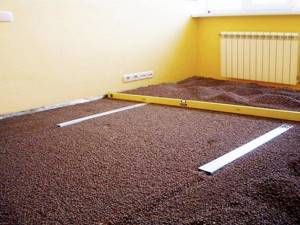
Advantages of expanded clay:
- The main raw material for the production of expanded clay is considered to be natural clay. That is why the insulation in question has maximum environmental safety indicators.
- The granules have a porous structure, which affects high heat and sound insulation properties.
- The material can be laid by pouring granules or leveling the floor using concrete mortar laid between the beacons.
- The insulation in question is characterized by increased resistance to temperature changes.
- Expanded clay is quite light, it does not exert a significant load on the foundation of the building.
- The material is resistant to moisture and is not damaged by rodents, fungus and mold.
The disadvantages of using expanded clay are as follows:
- Insufficient strength of granules. This must be remembered when compacting a leveled surface;
- Expanded clay can absorb a certain amount of moisture, which is not released into the atmosphere immediately, but as the surface dries.
Features of floating floor insulation
A flooring structure that is not fixed to the base is called floating. It consists of layers of sound and heat insulation laid on the surface of the slab. The absence of a rigid connection to the base and walls significantly reduces the noise level in the premises.
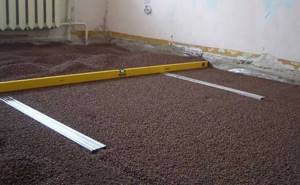
The process of insulating a floating floor Source polonest.ru
Insulation of a floating floor is carried out taking into account the following features:
- Insulation - bulk or slab (polystyrene, mineral wool) is placed on the screed or slab and carefully leveled.
- An edge is laid around the perimeter to create a gap between the wall and the floor structure.
- A hydro-vapor barrier is laid on top.
- The screed is poured over it and the floor covering is installed.
The screed can be replaced with moisture-resistant gypsum fiber sheets laid in two layers and glued together. It is important to move at least 10 mm away from the wall.
How to insulate floors in an old house
The first step is to inspect the remaining parts of the floor structure. They disassemble the covering, inspect the wooden elements for the presence of rot and fungi. All destroyed boards and bars are removed.

Insulating the floor in an old house will help make it cozy again Source giropark.ru
If the load-bearing beams are well preserved, insulation is carried out along the joists. Otherwise, they need to be replaced with healthy wood. All structural parts are treated with antiseptics. The thermal insulation material is protected from above and below with vapor and waterproofing. The work is completed by laying the flooring.
Thermal conductivity of materials
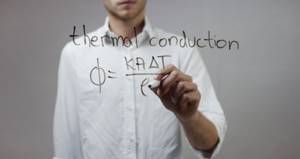
It is important to pay attention to the thermal conductivity value of the proposed materials, and then study their cost and possible availability at the nearest points of sale. This will make it possible to determine the optimal floor insulation for your home!
- Foam plastic – 0.03-0.035 W/m°C;
- Mineral wool – 0.049-0.60 W/m°C;
- Penofol – 0.037-0.049 W/m°C;
- Polyurethane foam (PPU) – 0.02 W/m°C;
- Expanded clay – 0.15 W/m°C;
- Basalt – 0.032-0.048 W/m°C;
- Wood – from 0.09 W/m°C;
- Air – 0.022 W/m°C!
There is no static, permanent data, since the indicated values are only average, and they depend on the manufacturer, quality and cost, and conditions of use. For example, with increasing density, thermal conductivity increases, as does when the material gets wet!


